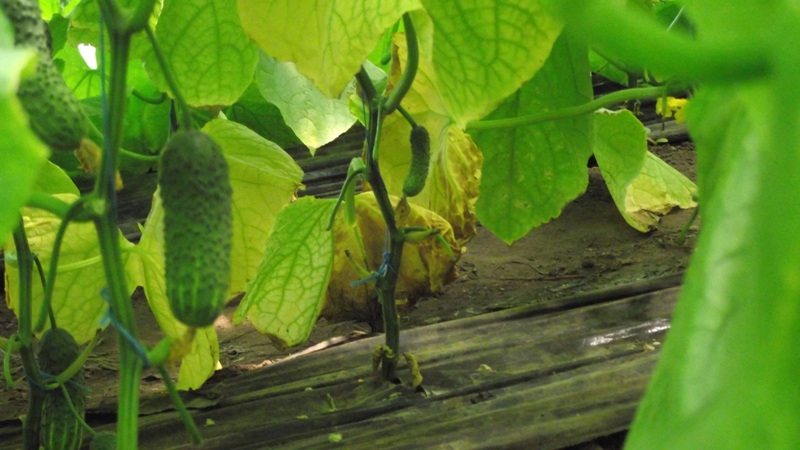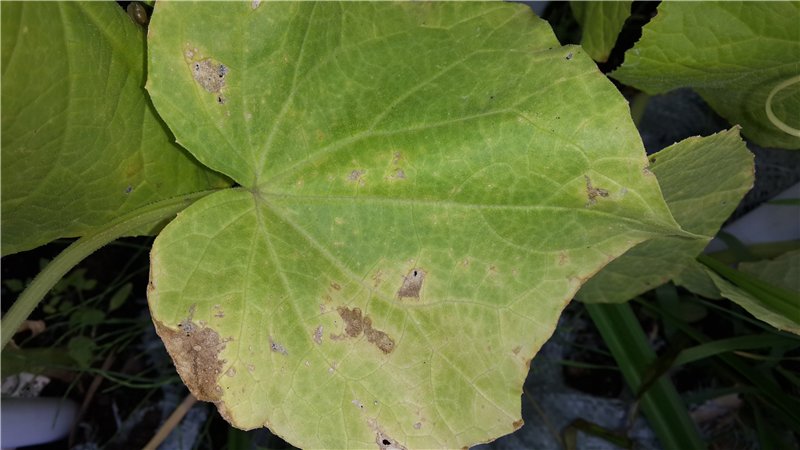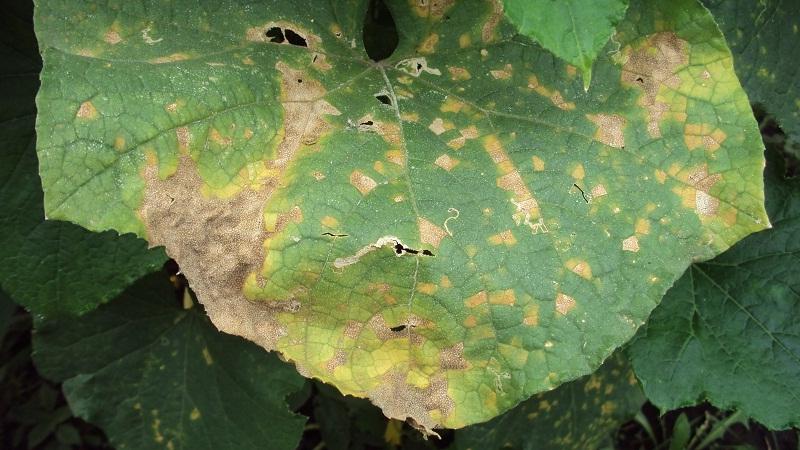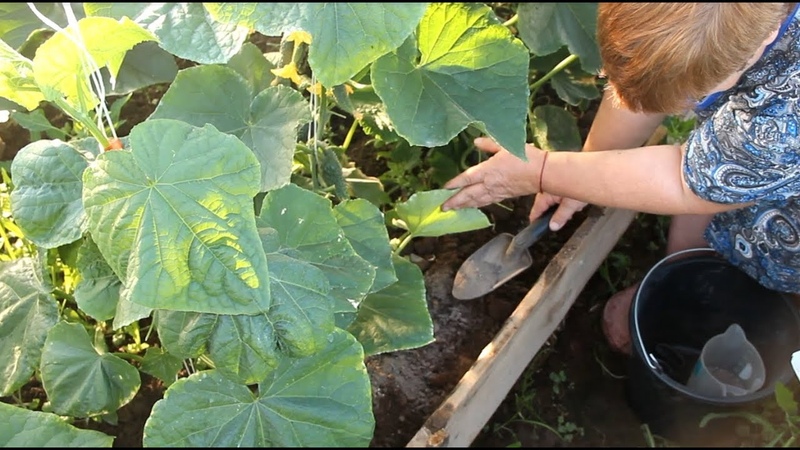What to do if cucumber leaves turn yellow: effective folk remedies
Cucumbers are one of the most unpretentious vegetables. Even an inexperienced gardener can grow them, adhering to simple rules of agricultural technology. The main problem faced by beginners is yellowing of the leaves, which can lead to the death of bushes.
The reasons for this are different - from drying out of the soil to damage to plants by aphids or fungus. If measures are not taken in time, the harvest may not be seen. It is important to bear in mind that cucumbers perfectly absorb the chemistry they are sprayed with. Why do cucumbers turn yellow leaves, what to do and what folk remedies to use, we will tell in the article.
The content of the article
Why do cucumber leaves turn yellow
Like any other plant, the cucumber lives by photosynthesis, which occurs in the leaves and stems. If the process is disrupted, the leaves turn yellow - the plant stops absorbing carbon dioxide and solar energy.

Severe yellowing will kill the plant. The main reasons for this:
- lack of nutrients in the soil;
- diseases - primarily fungal;
- pests - caterpillars, aphid;
- sudden changes in temperature;
- lack or excess of moisture in the soil;
- a small amount of sunlight;
- decay of roots and leaves;
- root trauma;
- early end of the growing season.
Each of these problems can be dealt with, the main thing is to notice it in time.
Lack of sunlight
Cucumbers planted in the shade of trees or buildings regularly upset the owners with drying out yellowing leaves... Vegetables need bright light, so you need to choose a sunny, bright place for the beds and greenhouses.
Lack or excess of moisture
Dull with yellow spots at the edges, the leaves can become both from a lack of moisture and from an excess of it.
Drought is easier to cope with - with the resumption of regular watering, cucumbers recover very quickly. If there is too much moisture, then from excessive watering and constant rains, the roots and leaves may begin to rot.
Reference. For urgent plant rehabilitation, a mixture of sand and wood ash is introduced into the soil under the bushes, after which the top layer of the earth is loosened.
Hypothermia or sudden temperature fluctuations

With a sharp hypothermia, the plant experiences stress - both the lower and upper leaves turn pale and turn yellow. To make cucumbers feel good outdoors, cover the beds with plastic on especially cold nights.
Root damage
When the roots rot or are damaged, the plant dies without getting enough moisture and nutrients. You can damage the roots by loosening too deeply or inept weeding - in this case, the root system is restored quickly. If the roots are rotting, change the watering frequency and sprinkle the soil with sieved ash.
Sunburn
It occurs most often with improper watering, when the plant is watered in the very heat.If brown spots appear on the leaves, it is worth slightly shading the beds and be sure to postpone watering for the evening or morning.
Fungal infections and other diseases
Fungal diseases can completely destroy an entire vegetable plantation in a few weeks. Fungus infection is easy to identify - it manifests itself in the form of spots of various shapes on the leaves.
Cucumbers are amazed:
- powdery mildew;
- peronosporosis;
- fusarium;
- bacteriosis.
The most common type of fungal disease is late blight.
Pest infestation
Aphids carried by garden ants, whiteflies, spider mites can gnaw through leaves, damaging tissues and sucking out all the juices from the plant.
At the site of the appearance of the parasite, a yellowish-brown speck is formed, which gradually spreads to the entire leaf.
Due to the violation of the processes of photosynthesis, the leaf turns yellow and dies.
Lack of nutrients
Poor, marginal soils cannot provide the plant with all the necessary nutrients. If the leaves turn brown from a lack of potassium or other trace elements, it is necessary to apply a complex mineral fertilizer and do not forget about organic matter.
Physiological aging process
In the fall, plants begin to turn yellow naturally - this is a process that cannot be influenced - and not necessary.
Varieties of yellowing

The leaves themselves will tell about the deficiency of nutrients. If the plate turns pale and becomes yellowish, nitrogen deficiency is possible. Gradually, such a leaf will begin to roll the edges down.
Leaves turn yellow and curl
With a lack of calcium, the plates twist and die off. Twisting is also typical for plants affected by pests or fungal diseases.
On a note. Rolling leaves can also indicate a lack of nitrogen.
The lower leaves turn yellow
If the lower leaves of the bushes have gradually turned yellow, do not worry. The foliage of cucumbers is dense, so the lower leaves may simply not have enough sunlight. Yellowing and falling off in this case is a normal physiological process of getting rid of excess foliage.
Simultaneous yellowing of leaves and ovary
The most dangerous thing in growing cucumbers is the simultaneous wilting of the leaves and ovaries... Measures must be taken immediately, otherwise the harvest may not be at all.
Main reasons:
- lack of sunlight;
- starvation - a lack of nitrogen and potassium, which are easily washed out of the soil with regular abundant watering;
- hypothermia of the bushes.
To solve the problem, feed young bushes with complex fertilizer and cover the beds at night, as well as on cool windy days.
The edges of the leaves turn yellow
At the edges of the leaf, cucumbers darken due to lack of nutrients, mainly potassium. If a border appears on the bushes, which has a characteristic greenish-yellow color, apply a complex mineral fertilizer or feed the cucumbers with an infusion of wood ash.
Leaves turn yellow spots

Most often, this indicates infection with late blight or some other fungal disease. The leaves turn unevenly and when pests appear that bite through the leaf tissue - it is at the puncture site that the first brownish-yellow spot is formed.
Also, a spotted color may indicate a deficiency of specific trace elements:
- with a lack of potassium, spots appear that resemble a sunburn;
- with a lack of magnesium, the spots are yellow-green, gradually spreading to the entire leaf.
If you do not add top dressing, the plates will continue to dry out and die.
How to deal with yellowing with folk remedies
If it was not possible to solve the problem by adjusting watering and covering the beds, it is necessary to take measures to eliminate the main problem. It is possible to feed plants and destroy pests without the use of serious chemicals.
How to process cucumbers with a lack of nutrition

An excellent top dressing that supplies green vegetables with all the nutrients - an infusion of ash and mullein.
To prepare the fertilizer, 300 g of dry sieved ash is poured into a bucket with a capacity of 10 liters, 200 g of dry mullein is added and insisted for a day. After that, plants are watered at the rate of 1 liter per bush.
After a week, feed the plants again. Then fertilize every two weeks until harvest is complete.
Treatment against diseases and pests
You can cope with any kind of fungus with a 1% solution of Bordeaux liquid. The solution of "Nitroammofoski" copes with aphids (2-3 ml per 10 liters of water).
Colloidal sulfur solution destroys spider mites - for treatment, dilute 80 g of sulfur in a 10 l bucket with water and process bushes every 3-5 days.
You can wash leaves affected by fungus or aphids with a mild soapy solution (use only non-perfumed laundry soap). After washing, sprinkle dark spots with sifted ash - it will create an alkaline environment in which the fungus will not survive.
It is necessary to repeat the soap treatment and powder every 3-4 days until the symptoms disappear completely.
If the fungus is resistant, treat the bushes with a mild baking soda solution. A tablespoon of powder is diluted in a 5 liter bucket of water and the leaves are processed with a spray bottle.
Important! When processing with natural soda, observe the dosage. A more concentrated solution can burn and blacken the leaves.
A stronger solution (half a glass of baking soda per 10 liters of water) wash the walls of the greenhouse every three days.
In other cases

To prevent yellowing of the leaves and urgent rehabilitation, it is useful to process plantings with solutions according to folk recipes every two weeks:
- Milk and soap composition. In a bucket with a capacity of 10 liters, collect 8 liters of water, add half a liter of low-fat milk, 20 g of simple laundry soap and 20 drops of iodine. Stir until the soap chips are completely dissolved. Treat the leaves with a solution every 10-12 days to prevent the appearance of caterpillars, aphids, viral diseases and fungus.
- Rye bread with iodine. For 12 hours, a loaf of dry rye bread is soaked in a bucket of water. After completely soaking, the bread is ground in water by hand, 30-40 drops of iodine are added to the mixture. The solution is filtered through several layers of gauze and poured into a clean bucket. Greens are sprayed with a solution every 14 days - against pests and for additional feeding.
- Infusion of onion peels. An excellent tool used by experienced farmers for many decades. Grated husk in the amount of 30 g is poured into 10 liters of water. The mixture is boiled for one minute, cooled and insisted for about a day. Strain, dilute with water 1/1 and spray the leaves with the resulting solution. The infusion is not stored - the leftovers are poured under the bush: this is an excellent fertilizer for cucumbers.
If vegetables are grown in a greenhouse or under plastic, the bushes should be regularly ventilated by opening the greenhouse door or raising the cover. Excessive moisture creates a favorable environment for the development of diseases, especially fungi.
How to prevent yellowing of cucumber leaves
To keep the cucumbers strong and healthy, the leaves do not turn yellow and remain green, it is enough to follow simple rules:
- cover plants with a film during periods of a sharp drop in air temperature;
- prevent the soil under the vegetables from drying out;
- process the greenhouse, soil, fruits and leaves from pests;
- do not neglect feeding;
- do not water the plants in the very heat - watering is carried out either early in the morning or in the evening, when the temperature drops and solar activity is minimal.
Conclusion
Caring for cucumbers is not difficult, but even in this matter, you should not neglect the rules of agricultural technology so that the leaves of the plant do not start to turn yellow. In this case, there is a risk of being left without a crop.
The main task when yellowing of cucumber leaves appears is to establish the cause and eliminate it as soon as possible. With the prompt destruction of the fungus, aphids or the introduction of fertilizer into the soil, the problem will disappear in a few days.